
Portland is the most populous city in the U.S. state of Oregon, located in the Pacific Northwest region. Situated in the northwestern area of the state at the confluence of the Willamette and Columbia rivers, it is the county seat of Multnomah County, Oregon's most populous county. As of 2020, Portland's population was 652,503, making it the 26th-most populous city in the United States, the sixth-most populous on the West Coast, and the second-most populous in the Pacific Northwest, after Seattle. Approximately 2.5 million people live in the Portland metropolitan area, making it the 25th-most populous in the United States. About half of Oregon's population resides within the Portland metro area.

Beaverton is a city in the Tualatin Valley, located in Washington County in the U.S. state of Oregon, with a small portion bordering Portland. The city is among the main cities that make up the Portland metropolitan area. Its population was 97,494 at the 2020 census, making it the second most populous city in the county and the seventh-most populous city in Oregon. Beaverton is an economic center for Washington County along with neighboring Hillsboro.
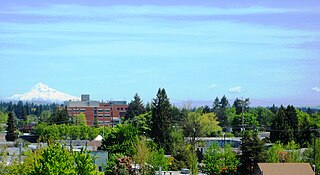
Hillsboro is a city in the U.S. state of Oregon and is the county seat of Washington County. Situated in the Tualatin Valley on the west side of the Portland metropolitan area, the city hosts many high-technology companies, such as Intel, locally known as the Silicon Forest. The population was 106,447 at the 2020 census, making Hillsboro the fifth-most populous city in Oregon.
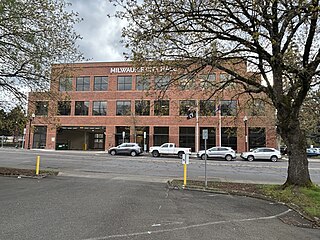
Milwaukie is a city mostly in Clackamas County, Oregon, United States; a very small portion of the city extends into Multnomah County. The population was 21,119 at the 2020 census. Founded in 1847 on the banks of the Willamette River, the city, known as the Dogwood City of the West, was incorporated in 1903 and is the birthplace of the Bing cherry. The city is now a suburb of Portland and also adjoins the unincorporated areas of Clackamas and Oak Grove.

Portland State University (PSU) is a public research university in Portland, Oregon, United States. It was founded in 1946 as a post-secondary educational institution for World War II veterans. It evolved into a four-year college over the next 20 years and was granted university status in 1969. It is one of two public universities in Oregon that are in a large city. It is governed by a board of trustees. PSU is classified among "R2: Doctoral Universities – High research activity".

Oregon State University (OSU) is a public land-grant research university based in Corvallis, Oregon. OSU offers more than 200 undergraduate-degree programs along with a variety of graduate and doctoral degrees through all 11 colleges. It has the seventh-largest engineering college in the nation for 2023. Undergraduate enrollment for all colleges combined averages over 32,000 while an additional 5,000 students are engaged in post-graduate coursework through the university. In 2023, over 37,000 students were enrolled at OSU – making it the largest university in the state. Out-of-state students typically make up over one-quarter of the student body. Since its founding, over 272,000 students have graduated from OSU. The university is classified by the Carnegie Classification of Institutions of Higher Education as an R1: Doctoral University with very high research activity.

Mark Odom Hatfield was an American politician and educator from the state of Oregon. A Republican, he served eight years as Governor of Oregon, followed by 30 years as one of its United States senators, including time as chairman of the Senate Appropriations Committee. A native Oregonian, he served in the United States Navy in the Pacific Theater during World War II after graduating from Willamette University. After the war he earned a graduate degree from Stanford University before returning to Oregon and Willamette as a professor.
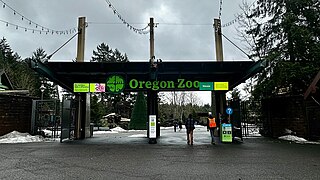
The Oregon Zoo, originally the Portland Zoo and later the Washington Park Zoo, is a zoo located in Washington Park, Portland, Oregon, approximately 2 miles (3.2 km) southwest of downtown Portland. Founded in 1888, it is the oldest zoo west of the Mississippi River.

Barbara Kay Roberts is an American politician from the state of Oregon. A native of the state, she served as the 34th Governor of Oregon from 1991 to 1995. She was the first woman elected to serve as Oregon governor, and the only woman elected to that office until 2016. A Democrat, Roberts was also the first woman to serve as majority leader in the Oregon House of Representatives. She also won two terms as Oregon Secretary of State, and served in local and county government in Portland. Roberts was married to Oregon state Sen. Frank L. Roberts from 1974 until his death in 1993. From February 2011 until January 2013, she served on the council of Metro, the regional government in the Portland metropolitan area.

Metro is the regional government for the Oregon portion of the Portland metropolitan area, covering portions of Clackamas, Multnomah, and Washington Counties. It is the only directly elected regional government and metropolitan planning organization in the United States. Metro is responsible for overseeing the Portland region's solid waste system, general planning of land use and transportation, maintaining certain regional parks and natural areas, and operating the Oregon Zoo, Oregon Convention Center, Portland's Centers for the Arts, and the Portland Expo Center. It also distributes money from two voter-approved tax measures: one for homeless services and one for affordable housing.
Oregon Health & Science University (OHSU) is a public research university focusing primarily on health sciences with a main campus, including two hospitals, in Portland, Oregon. The institution was founded in 1887 as the University of Oregon Medical Department and later became the University of Oregon Medical School. In 1974, the campus became an independent, self-governed institution called the University of Oregon Health Sciences Center, combining state dentistry, medicine, nursing, and public health programs into a single center. It was renamed Oregon Health Sciences University in 1981 and took its current name in 2001, as part of a merger with the Oregon Graduate Institute (OGI), in Hillsboro. The university has several partnership programs including a joint PharmD Pharmacy program with Oregon State University in Corvallis.

The MAX Blue Line is a light rail line serving the Portland metropolitan area in the U.S. state of Oregon. Operated by TriMet as part of the MAX Light Rail system, it connects Hillsboro, Beaverton, Portland, and Gresham. The Blue Line is the longest in the network; it travels approximately 33 miles (53 km) and serves 48 stations from Hatfield Government Center to Cleveland Avenue. It is the busiest of the five MAX lines, having carried an average 55,370 riders each day on weekdays in September 2018. Service runs for 221⁄2 hours per day from Monday to Thursday, with headways of between 30 minutes off-peak and five minutes during rush hour. It runs later in the evening on Fridays and Saturdays and ends earlier on Sundays.

Carl Walter Salser, Jr. was an American author, businessperson and educator.
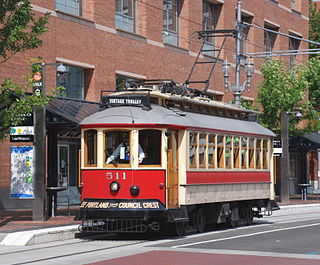
The Portland Vintage Trolley was a heritage streetcar service in Portland, Oregon, United States, that operated from 1991 to 2014. It operated on a portion of the MAX light rail system, and for a brief time also operated on the Portland Streetcar system, in downtown and nearby areas. Service was provided with replicas of a type of Brill streetcar, nicknamed the "Council Crest" cars, which last served Portland in 1950. The service was managed by Vintage Trolley Inc., a non-profit corporation, and the cars were owned and operated by TriMet, Portland's transit agency. For 18 of its 23 years, the service followed a 2.3-mile (3.7 km) section of what is now the MAX Blue Line, between Lloyd Center and the west end of downtown. In September 2009, the route was changed to a 1.5-mile (2.4 km) section of the MAX system, along the transit mall in downtown Portland, from Union Station to Portland State University (PSU).

Henry Winslow Corbett was an American businessman, politician, civic benefactor, and philanthropist in the state of Oregon. A native of Massachusetts, he spent his early life in the East and New York before moving to the Oregon Territory. He was a prominent figure in the early development of Portland, Oregon, and was involved in numerous business ventures there, starting in general merchandise. His interests later included banking, finance, insurance, river shipping, stage lines, railways, telegraph, iron and steel and the erection of Portland downtown buildings among other enterprises. A Republican, he served as a United States senator from 1867 to 1873.
The Council on International Educational Exchange (CIEE) is a non-profit organization promoting international education and exchange. It was founded in 1947 and is based in the United States. The organization is headquartered in Portland, Maine.
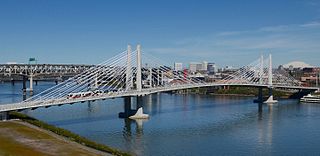
Tilikum Crossing, Bridge of the People is a cable-stayed bridge across the Willamette River in Portland, Oregon, United States. It was designed by TriMet, the Portland metropolitan area's regional transit authority, for its MAX Orange Line light rail passenger trains. The bridge also serves city buses and the Portland Streetcar, as well as bicycles, pedestrians, and emergency vehicles. Private cars and trucks are not permitted on the bridge. It is the first major bridge in the U.S. that was designed to allow access to transit vehicles, cyclists and pedestrians but not cars.

Oregon is a state in the Pacific Northwest region of the United States. It is a part of the Western U.S., with the Columbia River delineating much of Oregon's northern boundary with Washington, while the Snake River delineates much of its eastern boundary with Idaho. The 42° north parallel delineates the southern boundary with California and Nevada. The western boundary is formed by the Pacific Ocean.

The March for Science Portland was a protest held in Portland, Oregon. This local protest was part of the March for Science, a series of rallies and marches in Washington, D.C., and over 600 cities across the world on April 22, 2017. Portland Science Advocates organized the march in support of science and to protest President Donald Trump's plan to cut funding for the Environmental Protection Agency and the National Institutes of Health. Funding for the event, which cost approximately $30,000, was crowdsourced.
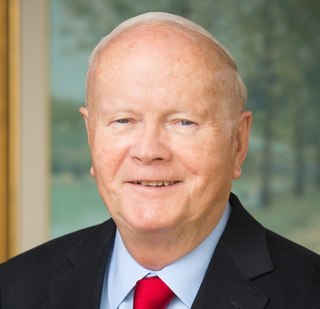
Earle Meyer Chiles was an American businessman and philanthropist from the US state of Oregon. He was born into a wealthy and influential business family. Chiles attended Menlo College and then graduate school at Stanford University. He worked in his family's retail business in Oregon, including serving on the board of directors of Fred Meyer, a large retail company founded by his grandfather. He was also chief executive officer of Earle Chiles and Affiliated Companies and president of the Chiles Foundation. Over the years, he contributed financially to numerous educational institutions and non-profit organizations.

















